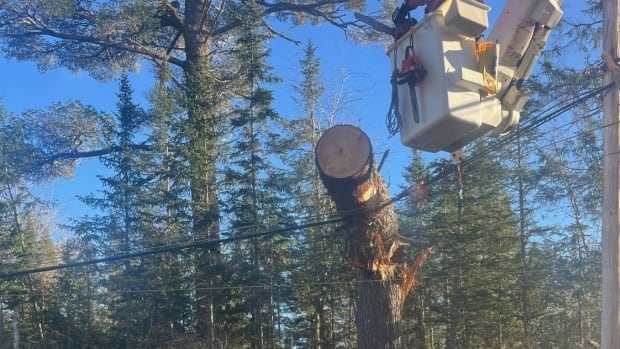N.B. Power is still totalling up costs from the pre-Christmas storm that cut service to 129,000 New Brunswick customers, but based on previous big storms it will be a multimillion-dollar bill.
The larger question is whether millions more should be spent to better protect N.B. Power’s distribution system from damage caused by similar weather events in the future, or whether that is even possible in a time of climate change.
“The restoration effort has become one of the largest in our company’s history,” said N.B. Power’s Dominique Couture in an email Tuesday about the extent of damage the utility dealt with following a Dec. 18 storm that brought heavy rains, damaging winds and widespread blackouts.
“We do know that this storm was one of the most intense wind events our province has seen.”
Couture said it is “too early” to know the costs of fixing damaged infrastructure and engaging more than 300 repair crews over eight days to restore service to every customer, but in 2022, the utility spent $7.1 million to deal with much less damage and fewer outages caused by post-tropical storm Fiona.
The pre-Christmas storm joins four others in the last decade that have hit New Brunswick with enough force to require six days or more to fully restore electricity from all of the outages left in their wake.
Those include a Christmas ice storm in 2013 in southern New Brunswick that took 11 days for the last customer to be reconnected; post-tropical storm Arthur in June 2014 that had some customers waiting 14 days for service; a January 2017 ice storm that knocked out power in northeastern New Brunswick for up to 12 days; and another intense wind storm in November 2018 that took six days to fully restore electricity.
Earlier this week, the last customers suffering outages from the Dec. 18 storm got their power back, on Day 8.
Last week, N.B. Power’s vice-president of operations, Nicole Poirier, said storms in New Brunswick have grown “more intense” than they once were and the utility has been attempting to protect its infrastructure as best it can.
“There is climate change. I think we can see it all around us and I think we see it in our storms,” she said.

To counteract that, N.B. Power has been trying to “harden” some of its equipment against the elements and widen distances between power lines and nearby trees, according to Poirier.
She said burying power lines has been looked at as a potential solution but the price is beyond reach for N.B. Power.
“The cost associated with burying underground wire is astronomical. At this point, there’s no business case to do that,” said Poirier.
“It’s not that it hasn’t been looked at and maybe in the future if things got cheaper you could do it but [now] there is no business case to do that. It’s too costly.”
The utility is constantly evaluating the costs and benefits of outage prevention versus outage repair.
This year, in a bid to save itself money in the short term, N.B. Power cut its budget for tree trimming and vegetation management around power lines to $14.1 million.
That’s down from $16.2 million the year before and less than the $14.8 million N.B. Power was budgeting for the same program six years ago, despite 24 per cent inflation since then.
The utility is proposing to add back to the vegetation management budget next year what was cut this year, but Couture said if a review of the recent storm and outages shows more money is needed for prevention, it will be looked at.
“We will review the response to this storm as we do for all major events,” said Couture.
“We routinely assess our vegetation management program and will continue to do so.”


